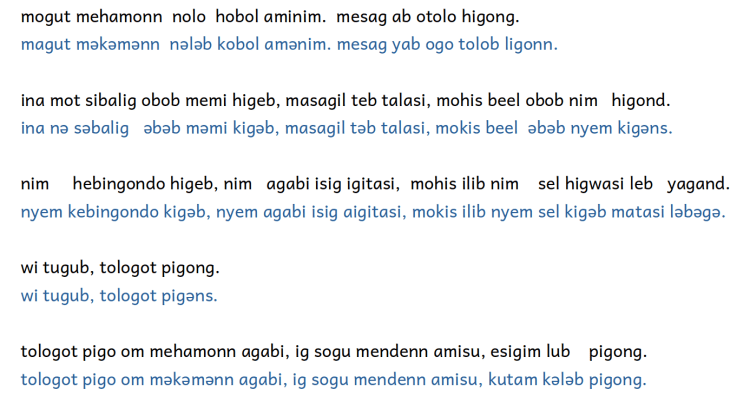First of all, I’d just like to say that we’re all feeling much better this week, and with the Stous family returning we’re not on our own anymore. We’re looking set to get a full week in this week and I even did my 30 minutes of exercise yesterday evening 🙂
Our orthography survey project seems to have run out of steam. We were asking literate Kovol speakers to answer a multiple-choice survey to indicate their preferences for spelling and symbol choices where we have multiple options. Ideally, we’d have 50 or so returns, but the 12 we have will need to make do as the momentum for finding people to fill it out has petered out. Those 12 were mostly group efforts though, so I guess more people were involved!

The first page of the survey was all about whether people would spell words like to talk as “hobol”, ” ‘obol” or “kobol”, because the two Kovol dialects use different sounds. The Matat dialect says [kɔβɔl] (as in Kovol) and Imengis says [ʔɔβɔl] (as in ovol).
Here’s what people choseː

The results are pretty clear. When given the choice Matat speakers will choose “k” and Imengis speakers will pick something else.
So either we need to just pick something and force one dialect to accept something they’d not choose, or we need two separate alphabets.
As we worked with Matat speakers on the survey it was discouraging to see that they didn’t like about 1/4 of the words on there. “We don’t say senyom for stick; we say sangat” and similar. I sat there thinking “This isn’t going to work if we can’t even use simple words with dialect variations being suggested!”
I decided to look at it from a different angle. I’ve been working on writing little 100-word stories to practise putting sentences together. I took one of these that I’d cleaned up and I got a Matat translation:

What I realised from doing so is that the grammar is pretty much the same. There are different word choices in places, but the general structure of how verbs conjugate is the same, and sentences and paragraphs don’t need to be reformated.
We do need to figure out what to do with the ə sound though. It’s a vowel sound equivalent to the kind of sound you make if someone hits you in the stomach: a grunt-like vowel. Matat is full of them and it makes my mouth feel heavy trying to speak with it!
We’re not sure which of our vowels it corresponds to – it seems to be a few of them.
Looking at the stories I’ve done so far it looks like it should be possible to create an Imengis – Matat translator. I can program a script to go word by word and phrase by phrase, look it up in a dictionary and then replace it with the Matat equivalent.
We’re not planning on learning to speak with a Matat dialect (I don’t think we’d be capable of learning both dialects and keeping them separate in our minds). We’re always going to speak with just an Imengis dialect, and we’re understood just fine by Matat speakers. When it comes to written materials though, what will we do?
Produce Imengis materials and expect Matat to adapt?
Produce written materials for both dialects?
Produce written materials that are a mix of both?
Just to throw another spanner in the works, strictly there really aren’t just the Matat and Imengis dialects. Within the Imengis dialect each village has their own pronunciation and spelling. When we say to throw, we say “teleb”, but Imengis speakers from over the river say “tolob”. Apparently, we don’t speak pure Imengis because we’re so near to Matat!
Whatever we choose we can’t keep everyone happy 🙂

I think that’s enough looking into this for now. I need to carry on learning the language and we’ll need to circle back to this again later. At some point, we’ll need to decide what to do, but we don’t need to yet. Hopefully, time and advice from literacy consultants will bring a bit of clarity!
It’s fascinating as we delve into this little PNG language though. Since it doesn’t have a written form there is no ‘official’ Kovol language; every family has their own version of it and everyone handles the ambiguity just fine. When we start producing written materials we in effect create a standard Kovol language, that’s an intimidating idea!



0 Comments